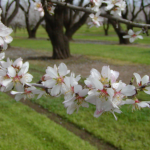Ant Mounds
Can you identify an ant by its mound? Of course, it’s better to base IDs off of the ant specimen itself, but for the more entomophobic among you, ant mound ID may sound like a fantastic alternative. Continue reading
Your source for orchard news & information in the Sacramento Valley



Can you identify an ant by its mound? Of course, it’s better to base IDs off of the ant specimen itself, but for the more entomophobic among you, ant mound ID may sound like a fantastic alternative. Continue reading

Recent research has shown we may have a new tool to protect trees and vines from vole damage. However, this product is not currently registered for such a use. We need your response to know whether there’s enough interest in a new way to control vole damage to warrant seeking registration. Continue reading

Training young walnut trees occurs in the first 1-6 years in the life of an orchard. Traditionally it has been done using a modified central leader with a minimum pruning style. Research conducted since 2004 investigating pruning versus non-pruning on young walnut tree growth and productivity has challenged that paradigm. Continue reading

2017 brought us unprecedented high and fluctuating water flows in the Sacramento and Feather Rivers, damaging orchards from direct flooding and indirectly via under-levee seepage. Many trees had a long exposure to waterlogged conditions through the winter and spring. This article discusses strategies for minimizing losses in 2018 in flood-impacted orchards. Continue reading

2017 brought us unprecedented high and fluctuating water flows in the Sacramento and Feather Rivers, damaging orchards from direct flooding and indirectly via under-levee seepage. Many trees had a long exposure to waterlogged conditions through the winter and spring. This article details our observations and research on tree survival, disease, and recovery. Continue reading

Growers are faced with an ever-changing list of commercial “tools”, each with the promise of providing some advantage to the farmer. With the large number of new products available, and the number of salespeople promoting them, it is often difficult for growers to distinguish between products likely to provide real benefit, and those that may actually reduce the profitability of the farm. When approached with a new product or technology it is obligatory to challenge claims with the following questions: Continue reading

Navel orangeworm (NOW) damage in the 2017 almond crop was painfully bad in many blocks in the Sacramento Valley. It cost some growers hundreds of dollars per acre, slowed crop processing (more money lost) and may be an issue in some international markets due to aflatoxin concerns. Continue reading

As soil treatment options become increasingly limited, more restrictive and less effective, the priority to identify a genetic solution to solve or reduce the replant issue is of increasing interest. One genetic solution is to find or develop rootstocks to help manage soil related problems. Also of interest are root and tree characteristics imparting canopy size control, good anchorage and little or no root suckering. In 2011, University of California Farm Advisors and campus based faculty designed and planted 3 large rootstock experiments to evaluate 29 prune rootstocks. Continue reading

After a long and bumpy ride, Kasumin 2L has received final EPA approval and will be available for walnut blight control in 2018. Here are some do’s and don’ts for using Kasumin 2L during the blight management season. Continue reading

All eyes have been on almonds during the recent cold snap, but the recent weather has reminded Bill Krueger, Farm Advisor Emeritus in Glenn County, of a similar cold snap in 2006 and the resulting damage to olive bloom. Here I have republished an article Bill wrote of his 2006 olive bloom observations. Continue reading

Generally, when I am working with growers on a problem related to potted-tree establishment, the cause is lack of water movement into the potted media, creating tree stress. This results from the difference in soil particle size at the boundary between the orchard soil and the tree’s potting soil. Continue reading

How are we doing on chill so far this year? Because there is not a CIMIS station close to Yuba City, Janine Hasey calculates chill based on a temperature recorder at the UCCE office in Yuba City. Chill data will be updated weekly. Continue reading

There are a few nights in the upcoming 10-day forecast that predict temperatures at 32°F or lower. This post contains resources if you need information about frost protection. Continue reading

Band canker has been an increasing problem in young almond orchards in recent years. Some hot spot areas have suffered high damage and occasionally required the replanting of an entire pollenizer variety. Symptomatic trees have gumming on the trunk. In the first year of infection, gumming may show as a ring or band around the trunk (hence its’ common name). Keep reading for the latest research results. Continue reading

Droughty winters prompt questions about winter irrigation in orchards. The questions seem simple: Should I irrigate this winter? If so, when should I irrigate? How much water should I apply? The answers to these questions aren’t quite so simple. Continue reading